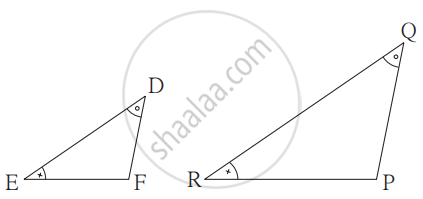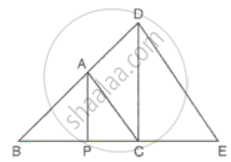Advertisements
Advertisements
प्रश्न
In the given figure, BC is parallel to DE. Area of triangle ABC = 25 cm2, Area of trapezium BCED = 24 cm2 and DE = 14 cm. Calculate the length of BC. Also, find the area of triangle BCD.

उत्तर
In ΔABC and ΔADE,
As BC || DE, corresponding angles are equal
∠ABC = ∠ADE
∠ACB = ∠AED
ΔABC ~ ΔADE
∴ `(ar(ΔABC))/(ar(ΔADE)) = (BC^2)/(DE^2)`
`25/49 = (BC^2)/14^2`
(ar(∆ADE) = ar(∆ABC) + ar(trapezium BCED))
BC2 = 100
BC = 10 cm
In trapezium BCED,
Area = `1/2 ("Sum of parallel sides") xx h`
Given: Area of trapezium BCED
= 24 cm2, BC = 10 cm, DE = 14 cm
∴ `24 = 1/2(10 + 14) xx h`
`=> h = 48/((10 + 14))`
`=>h = 48/24`
`=>` h = 2
Area of ΔBCD = `1/2 ` × base × height
= `1/2 xx BC xx h`
= `1/2 xx 10 xx 2`
∴ Area of ∆BCD = 10 cm2
APPEARS IN
संबंधित प्रश्न
`triangleDEF ~ triangleMNK`. If DE = 5 and MN = 6, then find the value of `(A(triangleDEF))/(A(triangleMNK))`
The given figure shows a trapezium in which AB is parallel to DC and diagonals AC and BD intersect at point P. If AP : CP = 3 : 5,

Find:
- ∆APB : ∆CPB
- ∆DPC : ∆APB
- ∆ADP : ∆APB
- ∆APB : ∆ADB
P and Q are points on the sides AB and AC respectively of a ΔABC. If AP = 2cm, PB = 4cm, AQ = 3cm and QC = 6cm, show that BC = 3PQ.
If in ∆DEF and ∆PQR, ∠D ≅ ∠Q, ∠R ≅ ∠E then which of the following statements is false?

The scale of a map is 1 : 200000. A plot of land of area 20km2 is to be represented on the map. Find:
The area in km2 that can be represented by 1 cm2
Points A(3, 1), B(5, 1), C(a, b) and D(4, 3) are vertices of a parallelogram ABCD. Find the values of a and b.
In the given figure ABC and CEF are two triangles where BA is parallel to CE and AF: AC = 5: 8.
(i) Prove that ΔADF ∼ ΔCEF
(ii) Find AD if CE = 6 cm
(iii) If DF is parallel to BC find area of ΔADF: area of ΔABC.
AM and DN are the altitudes of two similar triangles ABC and DEF. Prove that: AM : DN = AB : DE.
In the figure, DE || AC and DC || AP. Prove that `"BE"/"EC" = "BC"/"CP"`
In the given figure, UB || AT and CU ≡ CB Prove that ΔCUB ~ ΔCAT and hence ΔCAT is isosceles.
